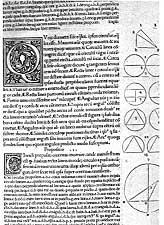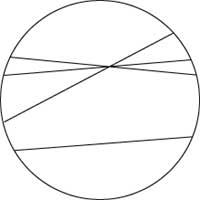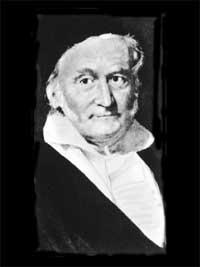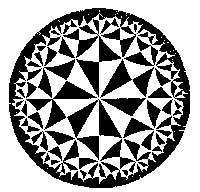Nikolai I. Lobatxevski (1792-1856): From nothing the new world
Rarely in the history of mathematics there has been something akin to aggravated by the discovery of non-euclidean Geometry. It established a crisis in the bases, but, as is customary, it was reinforced from the crisis, in such a way that it started from the new ways. As creators of non-euclidean geometry, two names are mainly cited: Russian Nikolai Lobatxevski and Hungarian János Bolyai. The year 1992 that has gone among the celebrations of the famous centuries has left us hidden to others, and one of them is the second of the birth of Lobatxevski.
Euclid and fifth postulate

In the third century a. C. the Greeks offered us the first book for the history of mathematics: Elements of Euclid of Alexandria. In it, numbers and geometry are analyzed. In addition to the topic, the important thing is the method, where the basis of the deductive axiomatic method used in Mathematics is found. First, there are claims (postulates or axioms) that should not be accepted and tested previously. Subsequently, applying the rules of Logic, other affirmations (propositions or theorems) are tested.
What conditions do we have to demand from postulates when we want to build a theory? On the one hand, they must not be contradictory (that is, they do not derive a result or the opposite). On the other hand, it should not be too much, although this would not ruin the theory. When are they too much? When a postulate is a consequence of others, it can be removed from the list of postulates and appear as theorem, leaving all the theory unchanged.
Euklides used five special postulates for Geometry. Although the formulation of the elements is more geometric, in plain words can be defined as:
- For either of the two points you pass a single straight.
- Given two directly, next to the first one can be placed another congruent with the second to give it a longer straight line.
- Given two different points, there is always a circumference that has as center the first and passes through the second.
- All right angles are congruent.
- If a straight cut other two straight lines and the sum of the inner angles on one side is less than two rectangular, they join extending the straight to that side.
Although the first four postulates seem to be accepted without doubt, for a long time it was perceived that the fifth is special. Euklides' work also shows something similar to this (since he tested the first 28 proposals without using this postulate and only introduced it when it was essential).
In later centuries, many mathematicians have taken care of the fifth postulate and can fix two positions: some, who did not like much the formulation of Euklides and who replaced it with another more “acceptable” formulation. Others tried to prove that the fifth postulate was a consequence of four others. Many of them gave the “demonstration”, but always involuntarily, with an alternative postulate. In the usual books and courses of Euclidean geometry, one of the alternative postulates occupied the place of what Euklides gave: From an outer point of a straight line, a single parallel straight line can be made. For this reason, the fifth postulate of parallels is called.

One way of seeing that the fifth postulate (in any of its formulations) is a consequence of the above is to take it to absurdity: considering that the opposite is true, to come to a contradiction. XIX. Before the 20th century, the most advanced on this path were the Italian Jesuit Gerolamo Saccheri (1677-1733) and the Swiss Johann Heinrich Lambert (1728-1777). Saccherik found interesting but rather rare looking results (Of course, comparing the euclidean geometries we are used to).
One of them was considered impossible and thus came to the conclusion that the postulate of the parallels is correct, as taught in the book Euklides garbi of all errors. Lambert stressed, among other things, that Saccheri did not come to contradiction and that he obtained more results for his part. In addition, he perceived that the fifth postulate could not be achieved as a consequence of others and that the results of the contrary can be rare from the usual experience, but in no case contradictory from the point of view of Logic. The only reason to accept the postulate of the parallels would, therefore, be convenience. Thanks to this, Lambert was a pioneer of works from the following century.
XVIII. At the end of the twentieth century, on the other hand, the opinion of the famous philosopher Kant also had a great influence on the debate. For Kant one cannot invent a Geometry other than euclidean, since it is a knowledge that we have beforehand (a priori).
Contribution of Lobatxevski
Like many others, Lobatxevski took his first steps to demonstrate the postulate of the parallels and thought he got it. It did not take long to take another path. The fifth postulate said that experience “proved” and that one cannot give a demonstration outside it, or that it is not due to the first four postulates. Moreover, the substitution of four other postulates by another postulate (not equivalent) and the construction of a Geometry other than the euclidean, also without contradictions. Despite Lambert's line we have mentioned above, it seems that Lobatxevski did not know his works.
The alternative postulate he proposed was: from an outer point of a straight line, two different lines can be made that join with the previous one. “Surfaces and lines are not in Nature, but in the imagination,” he will say clearly, leaving Geometry aside from the physical world (another thing is the one that best suits the needs of Physics). At first he verbally named Imaginary Geometry and, subsequently, Pangeometry. Currently it is called Hyperbolic geometry (sometimes also Lobatxevski geometry). The theorems shown in this geometry, as mentioned above, are not common. Here are a couple of examples:
- The sum of the angles of a triangle is smaller than two rectangles and its surface is proportional to the one that is missing to make that sum two rectangles.
- If the angles of two triangles are equal, the triangles are equal.

Lobatxevski also built the Trigonometry corresponding to this Geometry, also different from the usual one. But there are relations between the two who support each other, that is, if one is possible, the other is also.
Despite working in other fields, Lobatxevski is known for Geometry. In February 1826 he first spoke to the public of his new ideas and in 1829 he published this first topic in the Kazan Bulletin. Then came others, always in Russian, until in 1837 he drew a work in French in the famous Journal of Crelle (under the title of Imaginary Geometry) and three years later a monograph in German (Geometric Studies on the Theory of Parallels). A year before his death he published a complete explanation of the title Pangeometry, both in Russian and French.
Bolyai and Gauss
Lobatxevski was not the only one who reached these conclusions. The work “Science of Absolute Space” that the Hungarian János Bolyai (1802-1860) dedicated to his father, Wolfgang Bolyaire, to Juventutem Studiosam in Elementa Mathesis (1832-33) similar to that of Lobatxevski. When the young Bolyai in 1823 informed his father of his works, he told him in a letter: “I have made discoveries so fascinating that I have also lost the surprise: I have created a different new world out of nothing.” He was a friend of Wolfgang Bolyai Gauss and at that time he was the most famous mathematician. That's why he sent his son's job to give him his opinion.
Gauss's answer is: “If I say that I can’t praise this work, you will be surprised, but I can’t do anything else, because I would praise myself, because all the content of the work, the path your child has taken and the results he wants to achieve are almost entirely the reflections I’ve made in the last 30-35 years.” The young Bolyai hurt himself by listening to these words, hoping that Gauss would like to steal his results. On the other hand, despite Lobatxevski's work, he initially believed that he was copied from his work. As a consequence, he definitively abandoned Mathematics. But it is not so rare to get similar results from different researchers without copying. The following words of Wolfgang Bolyaire are very illustrative: “It seems that some consequences can be reached from many places, where they are in different places (as happened), as violets appear in spring.”
Gauss's work with non-euclidic geometries is not well known, since it seems that the reaction against the Kantian philosophers did not dare to say goodbye. According to some authors, the results of Lobatxevski and Bolyaire are based on ideas taken indirectly from Gauss and we should consider Gauss as the true creator of non-euclidean Geometry. Others, however, do not accept it and affirm that Gauss was never from the first steps and that we must confess to them what corresponds to Lobatxevski and Bolyai. In any case, it seems that Gauss rejoiced to take to the street the work of others, as he then praised Riemann's contribution in similar subjects. In addition, Lobatxevski's appointment as a member of the Göttingen Science Society (1842) was a proposal by Gauss.
Euclidean models
The renewal of geometry did not euclidean in the mathematical community was not noticed quickly. For this purpose years were necessary and, above all, the contribution of the Italian mathematician Eugenio Beltrami (1835-1900) gave him his place in Mathematics. The fact of not finding contradictions instead of the postulate of the parallels, did not ensure that it did not exist, since it is impossible to write all the theorems that could be deduced. But Beltrami discovered within Geometry a model that meets the requirements of hyperbolic Geometry and vice versa. Consequently, euclidean and hyperbolic Geometry are both possible or both impossible. It completely nullified the tendency to consider euclidean Geometry as a “truth”.

The Beltrami-Klein model (without going into details) is something like this: inside a circle the straight lines are normal (of course, the parts that are inside the circle), but the way of measuring distances changes and also that of measuring angles. The “lengths” increase as they approach the limit of the circle and, in fact, the length of a string of the circle is infinite. It is easy to observe that in this case the euclidean postulate of the parallels is not met. In this model Poincaré proposed a change. They are straight, diameters and pieces of circumference (attached to the circumference that is the limit of the circle) and the angles are measured normally, but not the distances.
Finally, let's say that unlike Newtonian Physics, modern Physics uses non-euclidean models to describe space. The reader interested in the evolution of non-euclidean geometry and its euclidean models in the magazine “Elhuyar” J. Llombart, A. Bernalte and M. You can see the following articles by Ensunza: Historical eraser of non-euclidean geometry, volume 11, vol. 2 (1985), pp. 263-271. and euclitric models of the hyperbolic plane, volume 12, vol. 2 (1986), pp. 1-3.
Brief biographical review Nikolai Ivanovitx Lobatxevski was born on 1 December 1792 in the city of Nizhniy-Novgorod (for several years called city of Gorki). Although another date of birth has also been mentioned, the investigations of Russian historians give it as true. However, that day was November 20 because the reform of the Gregorian calendar had not been approved. Being a five-year-old boy, his father left his family and his mother returned to his grandparents' home with his children. He studied at the Kanzan lyceum and in 1807 he entered the University of Kazan, founded two years earlier. In 1811 he finished his studies obtaining the title of Magister and there he was proposed to remain as a professor. In 1816 he was appointed Special Professor and that same year the scribe of the course of Geometry remained. In it do not appear the ideas that he later developed. In 1819 he received the order of reorganization of libraries and in 1820 he was appointed first dean of the Faculty of Physics and Mathematics. He was a professor in 1822, from 1825 to 1835. He was director of the library and rector of the University from 1827 to 1846. In 1842 he was appointed a member of the Science Society of Göttingen. In 1846, if for the first time he was appointed professor, 30 years passed and he was to retire by law. Since he was only 53 years old, they tried to obtain the exemption, but it was not possible and was appointed Representative of the Secretary of the Academic District of Kazan. In theory he was an important post, but for him he was totally bureaucratic and banal. He left the post in 1853 and died on February 23, 1856. |
Buletina
Bidali zure helbide elektronikoa eta jaso asteroko buletina zure sarrera-ontzian











